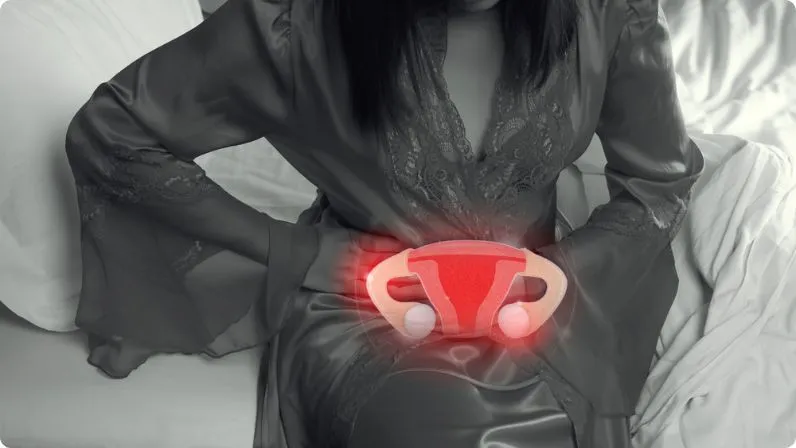Pelvic Inflammatory Disease (PID)
At Mamata Fertility Hospital in Secunderabad, we aim to empower women with knowledge about their reproductive health.
Pelvic Inflammatory Disease (PID) is a common but serious condition that can significantly affect fertility if left untreated. Understanding what PID is, its symptoms, and how it affects fertility can help women take the necessary steps toward prevention and treatment.
This comprehensive guide explains everything you need to know about PID and your reproductive health.
For Appointments, Please Call:
More On Pelvic Inflammatory Disease
What is Pelvic Inflammatory Disease?
Pelvic Inflammatory Disease (PID) is an infection of the female reproductive organs, including the uterus, fallopian tubes, and ovaries.
It typically occurs when harmful bacteria travel from the vagina to these upper reproductive organs. PID is often linked to sexually transmitted infections (STIs), such as chlamydia and gonorrhea, but it can also result from other bacterial infections.
Although PID can be mild and go unnoticed in some cases, severe infections can lead to significant complications, including chronic pain and infertility. Early diagnosis and treatment are essential to preserving reproductive health and preventing long-term consequences.

Causes and Risk Factors
PID can develop for various reasons, but certain risk factors increase the likelihood of infection. Here’s what you should know:
Common Causes of PID
-
- Sexually Transmitted Infections: STIs, particularly chlamydia and gonorrhea, are the leading causes of PID. Bacteria from these infections can ascend from the vagina, spreading to the reproductive organs.
- Bacterial Imbalance: An overgrowth of harmful bacteria in the vagina, known as bacterial vaginosis, can lead to PID.
- Unsterile Medical Procedures: Procedures such as IUD insertion, childbirth, miscarriage, or abortion can occasionally introduce bacteria into the reproductive tract, causing PID.
Key Risk Factors
-
- Unprotected Sexual Activity: Engaging in unprotected intercourse with multiple partners greatly increases the risk of STIs and consequently PID.
- Previous PID Diagnoses: Women who have had PID in the past are at a higher risk of recurrence.
- Age: Women under the age of 25 are more susceptible to PID, as their reproductive organs are more vulnerable to bacterial infections.
- Douching: The practice of douching can disrupt the vaginal microbiome, allowing harmful bacteria to travel to the uterus and fallopian tubes.
Understanding these risk factors is the first step in reducing the likelihood of developing PID.
Symptoms and Diagnosis
Recognizing the signs of PID can help ensure timely medical care and prevent complications. However, it’s important to note that not all women experience noticeable symptoms.
Common Symptoms of PID
-
- Lower Abdominal Pain: Persistent pain in the lower abdomen or pelvic area is a key symptom of PID.
- Abnormal Vaginal Discharge: Women may notice an unpleasant-smelling, unusual discharge.
- Pain During Intercourse: Discomfort or pain during sexual activity is often associated with PID.
- Fever and Fatigue: A fever, combined with fatigue and general malaise, may signal an infection.
- Painful Urination: Some women experience burning or discomfort while urinating.
- Irregular Menstrual Bleeding: Spotting or heavier, irregular periods may develop as a result of PID.
If you experience any of these symptoms, seeking medical attention is critical for diagnosis and treatment.
How is PID Diagnosed?
Diagnosis involves a combination of a medical history review, physical examinations, and tests. Here’s what your doctor may do:
- Pelvic Examination: A physical exam checks for tenderness or abnormalities in the pelvis.
- Lab Tests: Blood tests may identify signs of infection, and a vaginal culture can detect bacteria causing PID.
- Imaging Tests: Ultrasound or other imaging tools may be used to inspect the reproductive organs for signs of an infection or damage.
- Laparoscopy: For severe or unclear cases, a minimally invasive procedure called laparoscopy may be performed to confirm the diagnosis and assess the damage.
Early detection plays a key role in managing PID effectively.
How PID Impact on Fertility?
One of the most concerning complications of untreated PID is its effect on fertility. The infection can harm the reproductive organs, particularly the fallopian tubes, leading to long-term issues.
How Does PID Affect Fertility?
-
- Blocked Fallopian Tubes: When the fallopian tubes are damaged or blocked due to scarring, it becomes difficult or impossible for eggs to travel to the uterus for fertilization. This condition is a leading cause of infertility.
- Ectopic Pregnancy: Damaged fallopian tubes increase the risk of ectopic pregnancy, where a fertilized egg implants outside the uterus. This is a life-threatening condition that requires immediate medical attention.
- Chronic Pelvic Pain: Persistent pain from scarring and inflammation can also complicate fertility treatments and overall quality of life.
Approximately 1 in 8 women with a history of PID face difficulties with conception. Addressing PID promptly is critical to preventing these complications.
Treatment and Prevention
The good news is that PID can be treated effectively, especially when caught early. Treatment aims to eliminate the infection, reduce inflammation, and prevent complications.
How is PID Treated?
- Antibiotics: A combination of antibiotics is typically prescribed to clear the infection. It’s important to complete the entire course, even if the symptoms improve early.
- Hospitalization: Severe cases of PID may require intravenous antibiotics or, in rare cases, surgical intervention to treat abscesses or other complications.
- Partner Treatment: If the infection is linked to an STI, your sexual partner(s) should also be treated to prevent re-infection.
Preventing PID
Prevention is the best approach to protecting your reproductive health. Here’s how to reduce your risk:
- Safe Sexual Practices: Always use barrier methods, such as condoms, and discuss sexual health openly with your partner.
- Regular Screenings: Periodic testing for STIs ensures early detection and treatment if needed.
- Avoid Douching: Allow your body’s natural processes to maintain vaginal health without interference.
- Seek Prompt Care: Treating STIs and infections immediately prevents the spread of bacteria to the reproductive organs.
Staying vigilant and proactive about your reproductive health reduces the likelihood of PID and its complications.
Lifestyle and Dietary Recommendations
Your overall health plays a significant role in how your body responds to infections and treatments. Here are some ways to support your reproductive system:
Healthy Nutrition
- Anti-Inflammatory Foods: Include leafy greens, berries, and fatty fish in your diet to minimize inflammation and support healing.
- Probiotics: Foods like yogurt and fermented vegetables help maintain a healthy balance of bacteria in your body.
- Hydration: Drink plenty of water to aid in detoxifying your body and promoting recovery.
Self-Care and Fitness
- Moderate Exercise: Engage in low-impact exercises such as walking or yoga to boost circulation and immune system function.
- Stress Management: Chronic stress can interfere with immune health; practices like meditation and deep breathing promote relaxation.
- Adequate Sleep: Aim for 7–8 hours of rest each night to allow your body the opportunity to repair and recover.
Small but consistent lifestyle changes can enhance your overall health and reduce your risk of infections.
Frequently Asked Questions (FAQs)
1. Can PID go away on its own?
No. PID requires medical treatment to eliminate the infection and prevent complications. Without treatment, it can lead to irreversible damage to your reproductive organs.
2. Is PID always caused by an STI?
Not always. While STIs are a leading cause, PID can also result from bacterial infections unrelated to sexual activity.
3. How long does treatment for PID take?
Most cases of PID improve with 2–3 weeks of antibiotic treatment. Severe cases may take longer and require additional interventions.
4. Can PID-caused infertility be treated?
Yes. Depending on the damage, treatments like IVF or surgery to remove scar tissue may help improve fertility outcomes for women with PID-related complications.
5. How can I tell if I have PID?
Lower abdominal pain, abnormal vaginal discharge, and irregular periods are common signs. If you suspect you have PID or notice unusual symptoms, consult your doctor immediately.
At Mamata Fertility Hospital, we provide compassionate care and expert treatment for women’s reproductive health challenges, including those caused by PID. If you have concerns about your fertility or reproductive health, reach out to our team today for guidance and personalized care.
Reviewd By

Dr Aarti Deenadayal Tolani
Clinical Director, Scientific In-Charge & Fertility Consultant
MBBS, MS ( OBGYN), FICOG
Expert in Reproductive Endocrinology, Infertility, Advanced Gynaec Ultrasound, and Faculty at Mamata Fertility Hospital.
Blogs and Articles

Differences Between Sterility and Infertility
Infertility is difficulty conceiving, often treatable. Sterility is the permanent inability to conceive. Know the difference, seek help.

Can Yeast Infection Cause Infertility?
Yeast infections don’t cause infertility. While discomfort and changes in cervical mucus may affect conception temporarily, proper treatment resolves this.

Does Female Masturbation Cause Infertility?
Female masturbation does not cause infertility. It’s a natural, healthy activity with no impact on ovulation, implantation, or conception.

